University Report: Performance Measurement and Evaluation Analysis
VerifiedAdded on 2023/06/04
|6
|1190
|134
Report
AI Summary
This report focuses on performance measurement and evaluation, specifically within public sector organizations. It begins by comparing and contrasting two articles: one examining the potential negative impacts of performance measurement systems, such as inaccurate records and biased attitudes, and the other highlighting the positive effects, including increased productivity and improved relationships with staff. The analysis reveals both similarities, such as the use of performance measurement as a benchmarking tool, and differences, particularly in the tone of voice and the emphasis on the potential drawbacks versus benefits. The report then offers recommendations for improving organizational performance, suggesting aligning individual employee activities with organizational goals, providing comprehensive business plans, involving employees in decision-making, and fostering a supportive management approach. The report concludes with a comprehensive reference list supporting the analysis and recommendations.
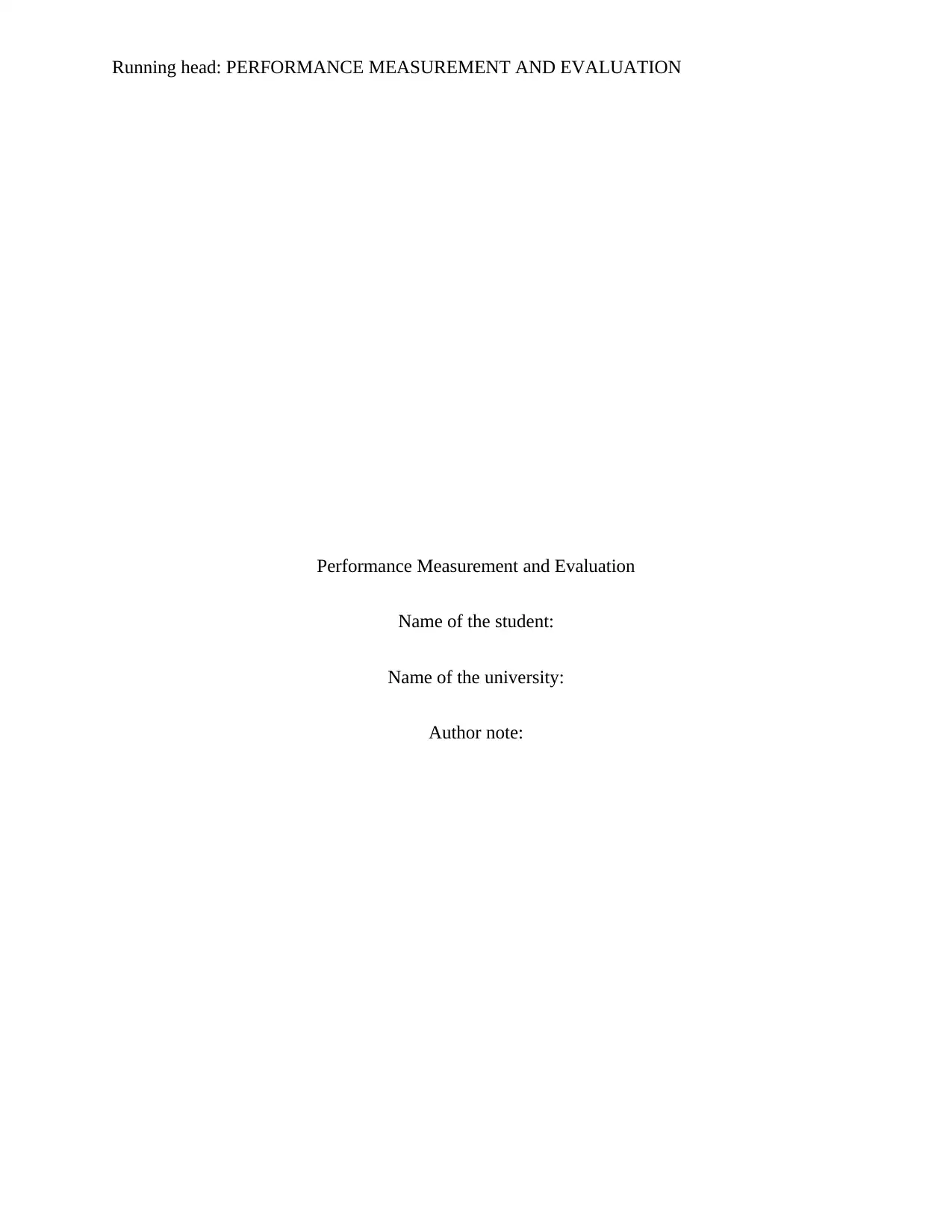
Running head: PERFORMANCE MEASUREMENT AND EVALUATION
Performance Measurement and Evaluation
Name of the student:
Name of the university:
Author note:
Performance Measurement and Evaluation
Name of the student:
Name of the university:
Author note:
Paraphrase This Document
Need a fresh take? Get an instant paraphrase of this document with our AI Paraphraser

1PERFORMANCE MEASUREMENT AND EVALUATION
Table of Contents
Comparing and contrasting two different articles:..........................................................................2
Recommendation on improving the performance level of an organization:...................................4
Reference List:.................................................................................................................................5
Table of Contents
Comparing and contrasting two different articles:..........................................................................2
Recommendation on improving the performance level of an organization:...................................4
Reference List:.................................................................................................................................5
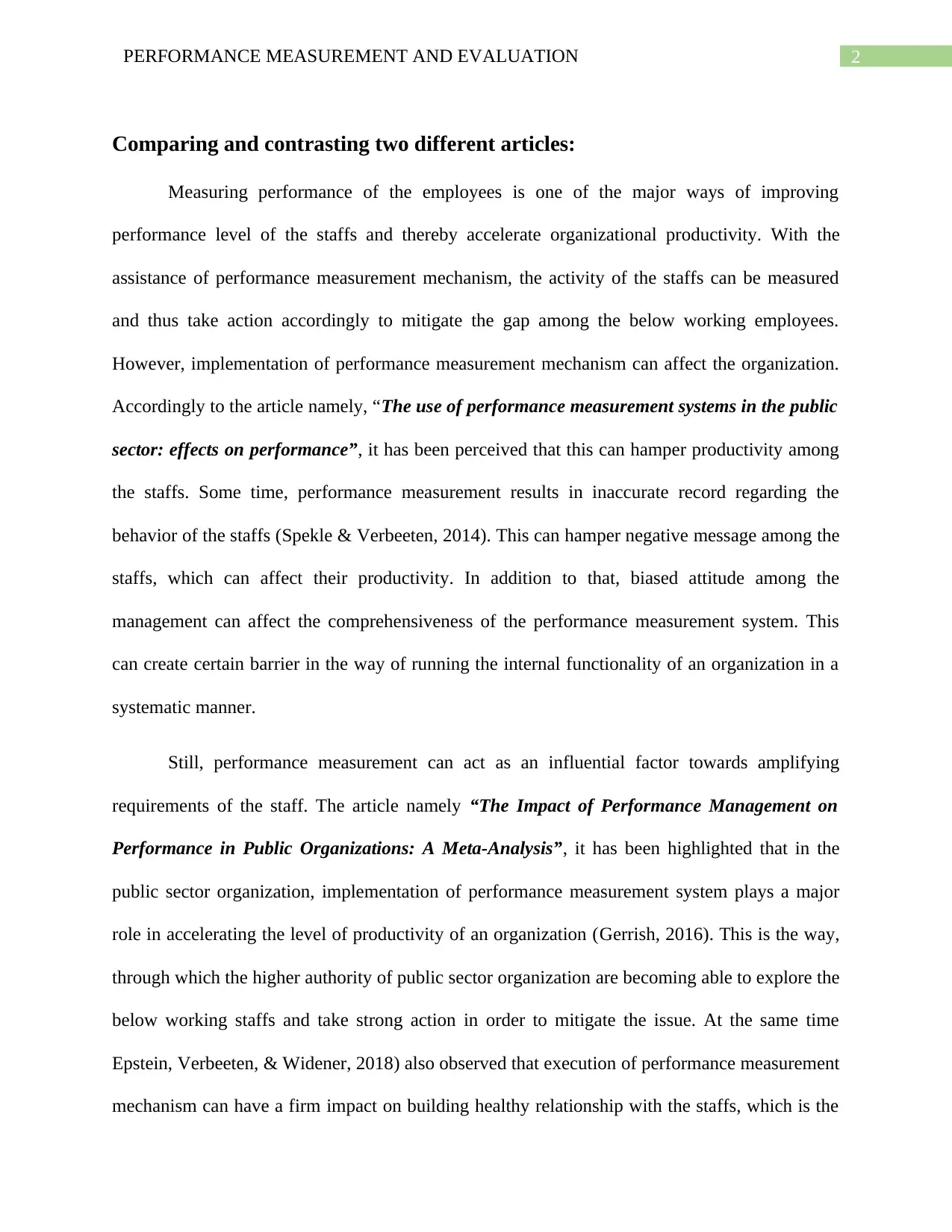
2PERFORMANCE MEASUREMENT AND EVALUATION
Comparing and contrasting two different articles:
Measuring performance of the employees is one of the major ways of improving
performance level of the staffs and thereby accelerate organizational productivity. With the
assistance of performance measurement mechanism, the activity of the staffs can be measured
and thus take action accordingly to mitigate the gap among the below working employees.
However, implementation of performance measurement mechanism can affect the organization.
Accordingly to the article namely, “The use of performance measurement systems in the public
sector: effects on performance”, it has been perceived that this can hamper productivity among
the staffs. Some time, performance measurement results in inaccurate record regarding the
behavior of the staffs (Spekle & Verbeeten, 2014). This can hamper negative message among the
staffs, which can affect their productivity. In addition to that, biased attitude among the
management can affect the comprehensiveness of the performance measurement system. This
can create certain barrier in the way of running the internal functionality of an organization in a
systematic manner.
Still, performance measurement can act as an influential factor towards amplifying
requirements of the staff. The article namely “The Impact of Performance Management on
Performance in Public Organizations: A Meta-Analysis”, it has been highlighted that in the
public sector organization, implementation of performance measurement system plays a major
role in accelerating the level of productivity of an organization (Gerrish, 2016). This is the way,
through which the higher authority of public sector organization are becoming able to explore the
below working staffs and take strong action in order to mitigate the issue. At the same time
Epstein, Verbeeten, & Widener, 2018) also observed that execution of performance measurement
mechanism can have a firm impact on building healthy relationship with the staffs, which is the
Comparing and contrasting two different articles:
Measuring performance of the employees is one of the major ways of improving
performance level of the staffs and thereby accelerate organizational productivity. With the
assistance of performance measurement mechanism, the activity of the staffs can be measured
and thus take action accordingly to mitigate the gap among the below working employees.
However, implementation of performance measurement mechanism can affect the organization.
Accordingly to the article namely, “The use of performance measurement systems in the public
sector: effects on performance”, it has been perceived that this can hamper productivity among
the staffs. Some time, performance measurement results in inaccurate record regarding the
behavior of the staffs (Spekle & Verbeeten, 2014). This can hamper negative message among the
staffs, which can affect their productivity. In addition to that, biased attitude among the
management can affect the comprehensiveness of the performance measurement system. This
can create certain barrier in the way of running the internal functionality of an organization in a
systematic manner.
Still, performance measurement can act as an influential factor towards amplifying
requirements of the staff. The article namely “The Impact of Performance Management on
Performance in Public Organizations: A Meta-Analysis”, it has been highlighted that in the
public sector organization, implementation of performance measurement system plays a major
role in accelerating the level of productivity of an organization (Gerrish, 2016). This is the way,
through which the higher authority of public sector organization are becoming able to explore the
below working staffs and take strong action in order to mitigate the issue. At the same time
Epstein, Verbeeten, & Widener, 2018) also observed that execution of performance measurement
mechanism can have a firm impact on building healthy relationship with the staffs, which is the
⊘ This is a preview!⊘
Do you want full access?
Subscribe today to unlock all pages.

Trusted by 1+ million students worldwide
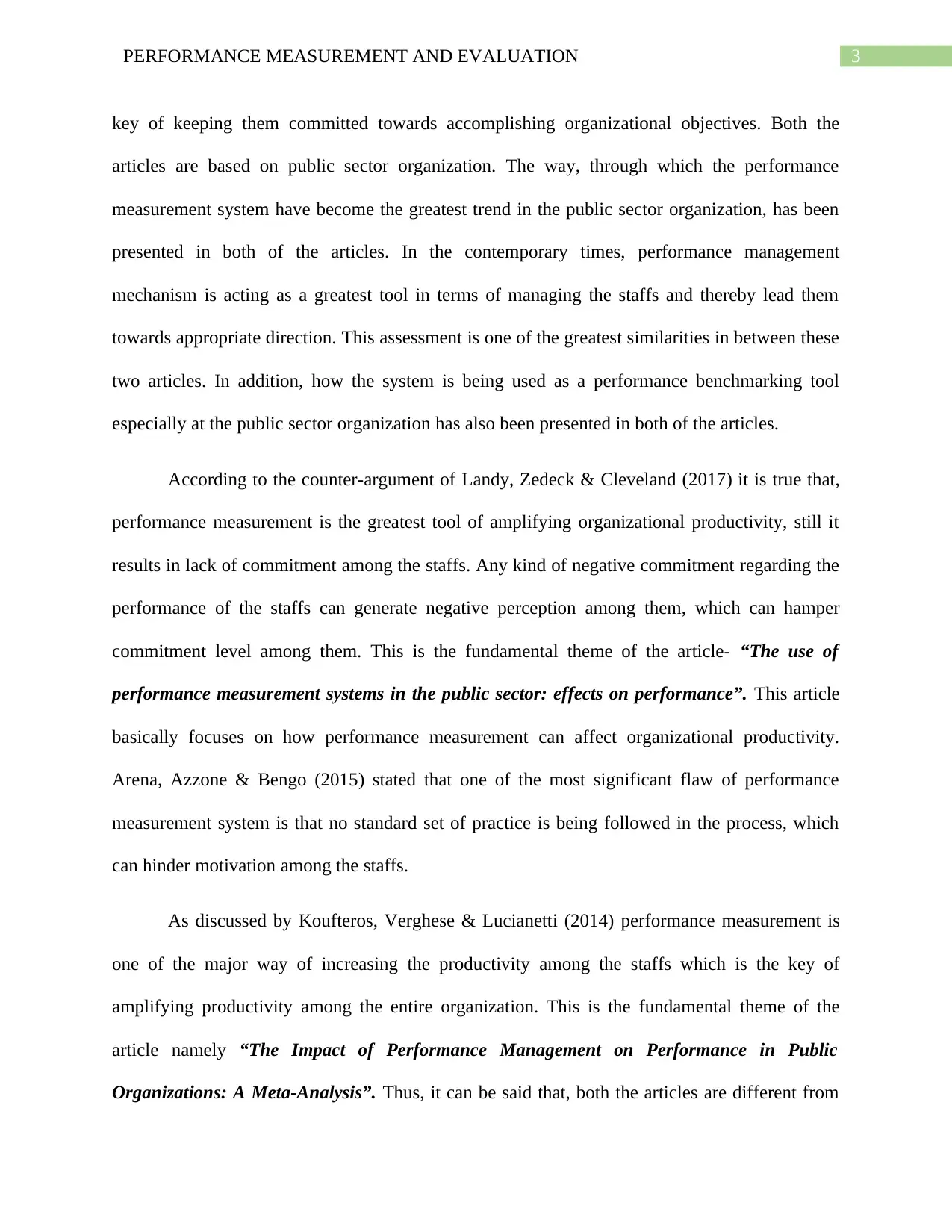
3PERFORMANCE MEASUREMENT AND EVALUATION
key of keeping them committed towards accomplishing organizational objectives. Both the
articles are based on public sector organization. The way, through which the performance
measurement system have become the greatest trend in the public sector organization, has been
presented in both of the articles. In the contemporary times, performance management
mechanism is acting as a greatest tool in terms of managing the staffs and thereby lead them
towards appropriate direction. This assessment is one of the greatest similarities in between these
two articles. In addition, how the system is being used as a performance benchmarking tool
especially at the public sector organization has also been presented in both of the articles.
According to the counter-argument of Landy, Zedeck & Cleveland (2017) it is true that,
performance measurement is the greatest tool of amplifying organizational productivity, still it
results in lack of commitment among the staffs. Any kind of negative commitment regarding the
performance of the staffs can generate negative perception among them, which can hamper
commitment level among them. This is the fundamental theme of the article- “The use of
performance measurement systems in the public sector: effects on performance”. This article
basically focuses on how performance measurement can affect organizational productivity.
Arena, Azzone & Bengo (2015) stated that one of the most significant flaw of performance
measurement system is that no standard set of practice is being followed in the process, which
can hinder motivation among the staffs.
As discussed by Koufteros, Verghese & Lucianetti (2014) performance measurement is
one of the major way of increasing the productivity among the staffs which is the key of
amplifying productivity among the entire organization. This is the fundamental theme of the
article namely “The Impact of Performance Management on Performance in Public
Organizations: A Meta-Analysis”. Thus, it can be said that, both the articles are different from
key of keeping them committed towards accomplishing organizational objectives. Both the
articles are based on public sector organization. The way, through which the performance
measurement system have become the greatest trend in the public sector organization, has been
presented in both of the articles. In the contemporary times, performance management
mechanism is acting as a greatest tool in terms of managing the staffs and thereby lead them
towards appropriate direction. This assessment is one of the greatest similarities in between these
two articles. In addition, how the system is being used as a performance benchmarking tool
especially at the public sector organization has also been presented in both of the articles.
According to the counter-argument of Landy, Zedeck & Cleveland (2017) it is true that,
performance measurement is the greatest tool of amplifying organizational productivity, still it
results in lack of commitment among the staffs. Any kind of negative commitment regarding the
performance of the staffs can generate negative perception among them, which can hamper
commitment level among them. This is the fundamental theme of the article- “The use of
performance measurement systems in the public sector: effects on performance”. This article
basically focuses on how performance measurement can affect organizational productivity.
Arena, Azzone & Bengo (2015) stated that one of the most significant flaw of performance
measurement system is that no standard set of practice is being followed in the process, which
can hinder motivation among the staffs.
As discussed by Koufteros, Verghese & Lucianetti (2014) performance measurement is
one of the major way of increasing the productivity among the staffs which is the key of
amplifying productivity among the entire organization. This is the fundamental theme of the
article namely “The Impact of Performance Management on Performance in Public
Organizations: A Meta-Analysis”. Thus, it can be said that, both the articles are different from
Paraphrase This Document
Need a fresh take? Get an instant paraphrase of this document with our AI Paraphraser
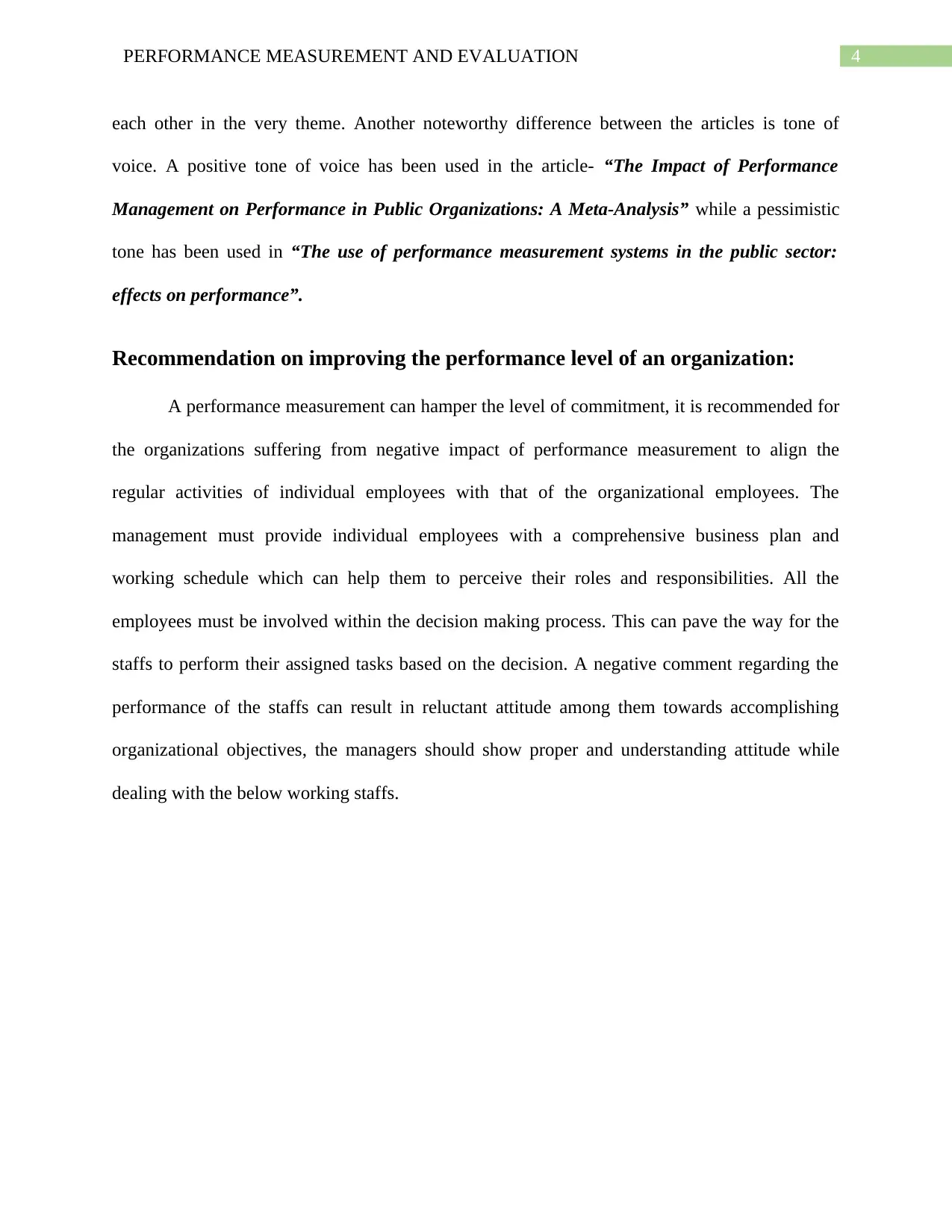
4PERFORMANCE MEASUREMENT AND EVALUATION
each other in the very theme. Another noteworthy difference between the articles is tone of
voice. A positive tone of voice has been used in the article- “The Impact of Performance
Management on Performance in Public Organizations: A Meta-Analysis” while a pessimistic
tone has been used in “The use of performance measurement systems in the public sector:
effects on performance”.
Recommendation on improving the performance level of an organization:
A performance measurement can hamper the level of commitment, it is recommended for
the organizations suffering from negative impact of performance measurement to align the
regular activities of individual employees with that of the organizational employees. The
management must provide individual employees with a comprehensive business plan and
working schedule which can help them to perceive their roles and responsibilities. All the
employees must be involved within the decision making process. This can pave the way for the
staffs to perform their assigned tasks based on the decision. A negative comment regarding the
performance of the staffs can result in reluctant attitude among them towards accomplishing
organizational objectives, the managers should show proper and understanding attitude while
dealing with the below working staffs.
each other in the very theme. Another noteworthy difference between the articles is tone of
voice. A positive tone of voice has been used in the article- “The Impact of Performance
Management on Performance in Public Organizations: A Meta-Analysis” while a pessimistic
tone has been used in “The use of performance measurement systems in the public sector:
effects on performance”.
Recommendation on improving the performance level of an organization:
A performance measurement can hamper the level of commitment, it is recommended for
the organizations suffering from negative impact of performance measurement to align the
regular activities of individual employees with that of the organizational employees. The
management must provide individual employees with a comprehensive business plan and
working schedule which can help them to perceive their roles and responsibilities. All the
employees must be involved within the decision making process. This can pave the way for the
staffs to perform their assigned tasks based on the decision. A negative comment regarding the
performance of the staffs can result in reluctant attitude among them towards accomplishing
organizational objectives, the managers should show proper and understanding attitude while
dealing with the below working staffs.
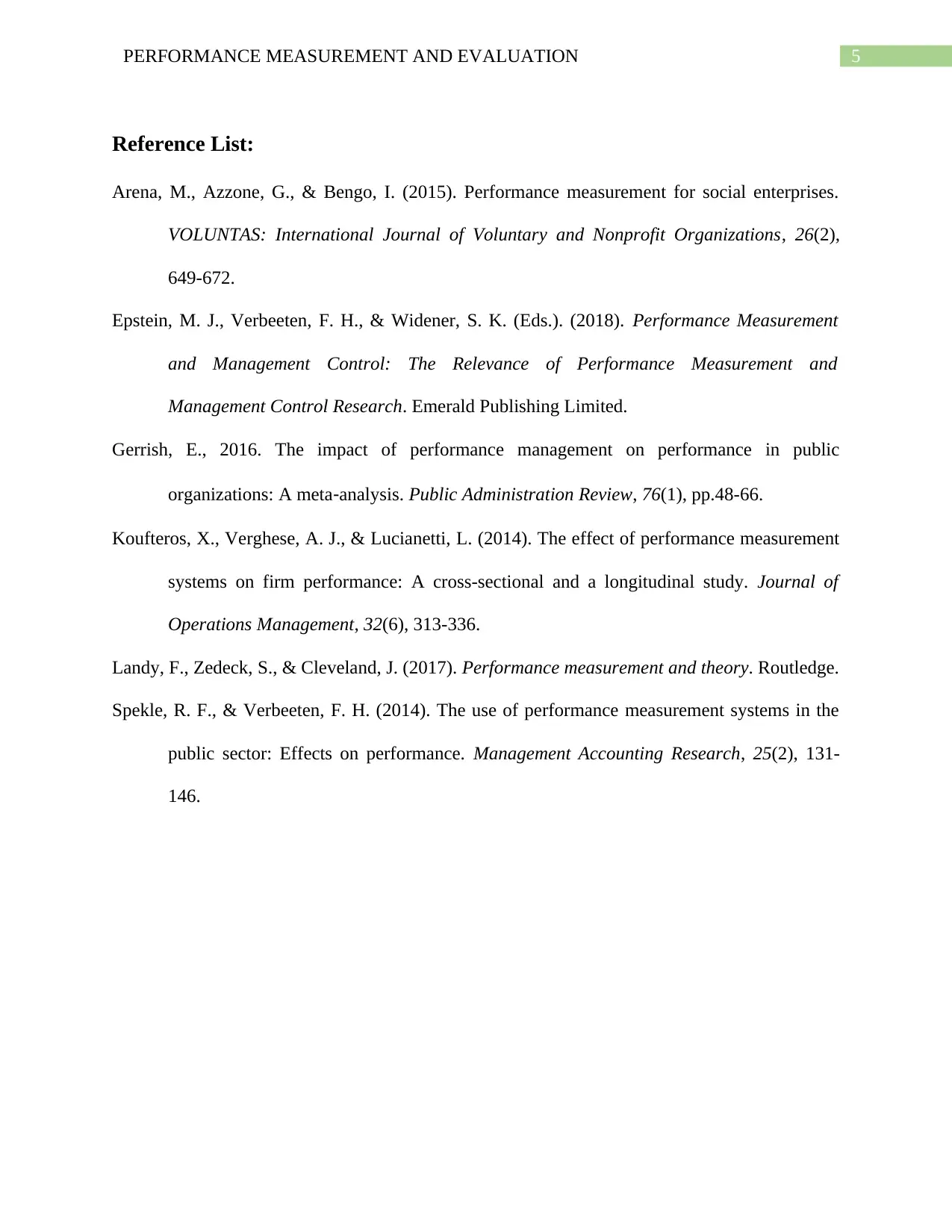
5PERFORMANCE MEASUREMENT AND EVALUATION
Reference List:
Arena, M., Azzone, G., & Bengo, I. (2015). Performance measurement for social enterprises.
VOLUNTAS: International Journal of Voluntary and Nonprofit Organizations, 26(2),
649-672.
Epstein, M. J., Verbeeten, F. H., & Widener, S. K. (Eds.). (2018). Performance Measurement
and Management Control: The Relevance of Performance Measurement and
Management Control Research. Emerald Publishing Limited.
Gerrish, E., 2016. The impact of performance management on performance in public
organizations: A meta‐analysis. Public Administration Review, 76(1), pp.48-66.
Koufteros, X., Verghese, A. J., & Lucianetti, L. (2014). The effect of performance measurement
systems on firm performance: A cross-sectional and a longitudinal study. Journal of
Operations Management, 32(6), 313-336.
Landy, F., Zedeck, S., & Cleveland, J. (2017). Performance measurement and theory. Routledge.
Spekle, R. F., & Verbeeten, F. H. (2014). The use of performance measurement systems in the
public sector: Effects on performance. Management Accounting Research, 25(2), 131-
146.
Reference List:
Arena, M., Azzone, G., & Bengo, I. (2015). Performance measurement for social enterprises.
VOLUNTAS: International Journal of Voluntary and Nonprofit Organizations, 26(2),
649-672.
Epstein, M. J., Verbeeten, F. H., & Widener, S. K. (Eds.). (2018). Performance Measurement
and Management Control: The Relevance of Performance Measurement and
Management Control Research. Emerald Publishing Limited.
Gerrish, E., 2016. The impact of performance management on performance in public
organizations: A meta‐analysis. Public Administration Review, 76(1), pp.48-66.
Koufteros, X., Verghese, A. J., & Lucianetti, L. (2014). The effect of performance measurement
systems on firm performance: A cross-sectional and a longitudinal study. Journal of
Operations Management, 32(6), 313-336.
Landy, F., Zedeck, S., & Cleveland, J. (2017). Performance measurement and theory. Routledge.
Spekle, R. F., & Verbeeten, F. H. (2014). The use of performance measurement systems in the
public sector: Effects on performance. Management Accounting Research, 25(2), 131-
146.
⊘ This is a preview!⊘
Do you want full access?
Subscribe today to unlock all pages.

Trusted by 1+ million students worldwide
1 out of 6
Related Documents
Your All-in-One AI-Powered Toolkit for Academic Success.
+13062052269
info@desklib.com
Available 24*7 on WhatsApp / Email
![[object Object]](/_next/static/media/star-bottom.7253800d.svg)
Unlock your academic potential
Copyright © 2020–2025 A2Z Services. All Rights Reserved. Developed and managed by ZUCOL.




